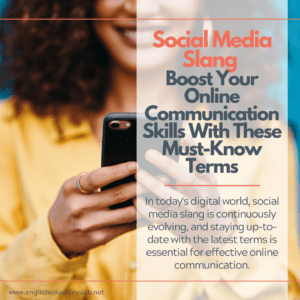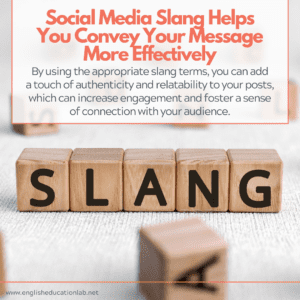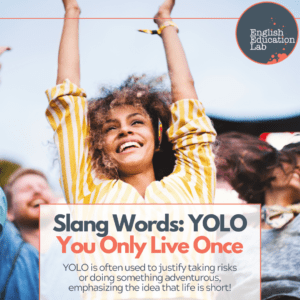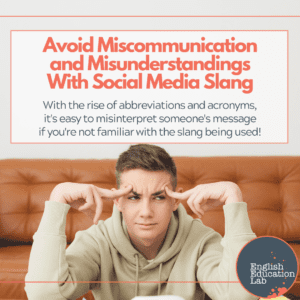
Social media slang: Boost your online communication skills with these must-know terms
Are you feeling out of the loop when it comes to online conversations? Don’t worry, I’ve got you covered! In today’s digital world, social media slang is continuously evolving, and staying up-to-date with the latest terms is essential for effective online communication. Whether you’re a social media enthusiast or a small business owner looking to connect with your target audience, mastering social media slang can give you a competitive edge.
In this post, I’ll delve into the must-know terms that will boost your online communication skills. From popular abbreviations like “LOL” and “OMG” to newer acronyms such as “FTW” and “TBH,” we will explore the meaning behind these expressions and how to use them appropriately. Not only will I demystify the jargon, but I’ll also provide real-life examples and tips for incorporating them into your daily interactions on various social media platforms.
So, whether you’re hoping to build connections, engage with your audience, or simply finally understand what everyone else is talking about (!), this post will help you master social media slang. Get ready to level up your online communication game and leave your audience wanting more.
Why is understanding social media slang important?
Let’s face it- in the age of social media, communication has taken on a whole new dimension. Text-based conversations have become the norm, and keeping up with the latest lingo is crucial to understanding and being understood. Understanding social media slang not only allows you to connect with others but also helps you navigate the intricate nuances of online communication.
It allows you to participate in conversations with ease. When you understand the terms and expressions being used, you can jump right in and engage with others. This is especially important for businesses that want to connect with their target audience and stay relevant in their industry.
Furthermore, social media slang helps you convey your message more effectively. By using the appropriate terms, you can add a touch of authenticity and relatability to your posts, which can increase engagement and foster a sense of connection with your audience. In a world saturated with content, mastering social media slang can help you stand out from the crowd and make your message more memorable.
Lastly, understanding social media slang allows you to avoid misunderstandings and miscommunication. With the rise of abbreviations and acronyms, it’s easy to misinterpret someone’s message if you’re not familiar with the words being used. By familiarizing yourself with common terms, you can ensure that your online interactions are clear and effective.
Common social media slang terms and their meanings
Now that we understand the importance of social media slang, let’s dive into some of the most common terms and their meanings. From popular abbreviations like “LOL” and “OMG” to newer acronyms such as “FTW” and “TBH,” cyber lingo is ever-evolving. Here are a few must-know terms:
1. LOL – Laughing Out Loud: This abbreviation indicates that something is funny or amusing. We use this in response to a joke or a humorous statement.
2. OMG – Oh My God: OMG is an expression of surprise or astonishment. We use this when something unexpected or shocking happens.
3. FTW – For The Win: FTW expresses enthusiasm or support for something. People often use it to express excitement or approval.
4. TBH – To Be Honest: TBH is used when someone wants to express their honest opinion about something. It’s often used as a preface before sharing a personal thought or feeling.
5. DM – Direct Message: DM refers to a private message sent directly to someone, away from public posts or comments.
6. BRB – Be Right Back: BRB lets others know that you will be temporarily stepping away and will return shortly.
7. FOMO – Fear Of Missing Out: FOMO is the anxiety or uneasiness that one might feel when they believe others are having a good time without them.
8. TL;DR – Too Long; Didn’t Read: TL;DR summarizes lengthy content, indicating that the information provided is a condensed version for those who may not have time to read the entire text.
9. SMH – Shaking My Head: SMH expresses disapproval, disappointment, or disbelief in response to something frustrating or absurd.
10. YOLO – You Only Live Once: YOLO is often used to justify taking risks or doing something adventurous, emphasizing the idea that life is short.
11. IRL – In Real Life: IRL is used to distinguish between online interactions and activities in the physical world. It’s often used to refer to things that happen outside the digital realm.
12. TBT – Throwback Thursday: TBT is a popular hashtag used on Thursdays to share nostalgic or old photos, memories, or experiences from the past.
These are just a few examples of common social media slang terms. The key is to familiarize yourself with the ones that are relevant to your target audience and/or industry. By incorporating these terms into your online communication, you can enhance your connection with others and make your messages more relatable.
How to use social media slang effectively in your online communication
Using virtual language trends effectively requires a delicate balance. While it’s important to stay relevant and connect with your audience, it’s equally important to use these terms in a way that feels natural and authentic to your brand voice. Here are some tips for incorporating social media slang into your online communication:
1. Understand the context: Before using any jargon, make sure you understand its meaning and context. Using a term incorrectly can lead to confusion or even offend your audience! Take the time to research and familiarize yourself with the slang that is relevant to your niche.
2. Be consistent with your brand voice: While it’s important to stay current with social media slang, it’s equally important to maintain a consistent brand voice. If your brand is more formal or professional, using slang that is too casual may not align with your overall image. Consider your target audience and the image you want to portray before incorporating social media jargon into your content.
3. Use slang sparingly: While social media slang can add personality and authenticity to your content, it’s important not to overdo it. Using too much slang can make your content feel forced or contrived. Use it sparingly and strategically to enhance your message without overwhelming your audience.
4. Test the waters: If you’re unsure about incorporating social media slang into your content, start by testing the waters. Use a few terms in your posts and monitor the response from your audience. If the feedback is positive and the engagement increases, you can gradually incorporate more slang into your content.
By following these tips, you can effectively use social media slang to enhance your online communication and connect with your audience on a deeper level.
The impact of social media slang on brand identity
In the fast-paced world of social media, brand identity is everything. It’s how your audience perceives you and what sets you apart from your competitors. Social media slang has the potential to impact your brand identity in several ways.
Firstly, using social media slang that is relevant to your target audience can make your brand more relatable and approachable. It shows that you understand the language and culture of your audience, which can build trust and foster a sense of connection. By speaking their language, you can create a deeper bond with your audience and cultivate brand loyalty.
On the other hand, using social media slang that doesn’t align with your brand identity can have negative consequences. Using slang that is too casual or inappropriate can undermine your reputation if your brand is known for its professionalism and expertise. It’s crucial to strike the right balance between staying relevant and maintaining your brand’s unique identity.
To ensure that social media slang aligns with your brand identity, it’s important to establish clear guidelines and standards for your content creators. Provide them with a framework to work within, ensuring that the slang used aligns with your brand voice and values.
Avoiding miscommunication and misunderstandings with social media slang
While cyber lingo slang can enhance communication, it’s important to be mindful of potential miscommunication and misunderstandings that can arise. The rise of abbreviations and acronyms makes it easy to misinterpret someone’s message if you’re unfamiliar with the slang. Here are some tips to avoid miscommunication:
1. Provide context: When using social media slang, it’s important to provide enough context for your audience to understand your message. Avoid using terms that are too obscure or niche, as this can lead to confusion. If necessary, provide a brief explanation or definition of the term to ensure clarity.
2. Use emoticons and emojis: Emoticons and emojis can help convey tone and emotion in text-based conversations. They can provide additional context and help prevent misunderstandings. When using slang, consider pairing it with an appropriate emoticon or emoji to enhance understanding.
3. Be open to questions: If you’re unsure whether your audience is familiar with a particular slang term, be open to questions and provide clarification when needed. Encourage your audience to ask for explanations or definitions if something is unclear. This can help foster a sense of community and mutual understanding.
By being mindful of potential miscommunication and taking steps to avoid misunderstandings, you can ensure that your online communication is clear and effective.
Social media platforms and their unique slang cultures
Each platform has its own unique slang culture. From Twitter (X) to Instagram to TikTok, the slang used on these platforms can vary significantly. Understanding the slang culture of each platform is essential for effective communication. Here are some examples:
1. Twitter: Known for its brevity, Twitter has popularized abbreviations and acronyms. Terms like “RT” (retweet), “DM” (direct message), and “MT” (modified tweet) are commonly used on the platform. Additionally, hashtags play a crucial role in Twitter conversations, allowing users to join larger discussions and connect with others who share similar interests.
2. Instagram: Instagram is all about visuals, and its slang reflects that. Terms like “IG” (Instagram), “IGTV” (Instagram TV), and “IG Stories” (Instagram Stories) are commonly used. Additionally, Instagram has popularized hashtags such as #OOTD (Outfit of the Day) and #TBT (Throwback Thursday).
3. TikTok: As the newest addition to the social media landscape, TikTok has its own unique slang culture. Terms like “duet,” “POV” (Point of View), and “For You Page” (the algorithmically curated feed) are commonly used. TikTok has also popularized dance challenges and trends, which often have their own slang terms.
By understanding the unique slang cultures of different social media platforms, you can tailor your communication to each platform and engage with your audience more effectively.
Resources for learning and staying updated on social media slang
Learning and staying updated on social media slang can be an ongoing process! Here are some resources to help you stay in the loop:
1. Online communities: Joining online communities and forums dedicated to social media can be a great way to stay updated on the latest slang trends. Engaging with other social media enthusiasts can help you discover new terms and understand their meanings.
2. Influencers: Following social media influencers in your niche allows you to gain insights into the latest slang being used. Influencers often have their finger on the pulse of social media trends and can introduce you to new terms and expressions.
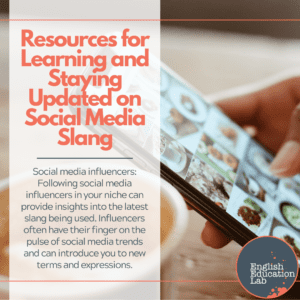 3. Trending hashtags: Stay updated on the latest slang used by monitoring trending hashtags on social media platforms. Hashtags often reflect current conversations and trends, so keeping an eye on them can give you valuable insights.
3. Trending hashtags: Stay updated on the latest slang used by monitoring trending hashtags on social media platforms. Hashtags often reflect current conversations and trends, so keeping an eye on them can give you valuable insights.
4. Online publications and blogs: Many online publications and blogs dedicated to social media regularly publish articles on the latest trends and slang. Consequently, following these publications and blogs can help you stay informed and learn new terms.
By actively seeking out resources and staying engaged in the social media community, you can continually expand your knowledge of its colloquialisms.
The future of social media slang
As social media continues to evolve, so does its slang! New terms and expressions are constantly emerging, reflecting the ever-changing landscape of online communication. Emerging platforms, technological advancements, and cultural shifts are likely to shape the future of social media slang.
The rise of artificial intelligence and voice assistants may lead to the development of new terms specifically tailored for these platforms. Additionally, as social media platforms continue to diversify and cater to different audiences, we can expect to see the emergence of new slang cultures. One thing is certain: social media slang is here to stay! As long as online communication continues to evolve, so will the slang that accompanies it. Staying up-to-date and adaptable will be key to mastering it in the future!
Some final thoughts
Mastering social media slang is essential for effective online communication. By understanding the meaning behind common terms and incorporating them into your online interactions, you can enhance your connection with others and make your messages more relatable. Remember to use them strategically, staying true to your brand voice and values. By avoiding miscommunication and staying updated on the latest trends, you can navigate the ever-changing landscape of social network colloquialisms with confidence. So, get out there and start boosting your online communication skills!
If you’re interested in learning and incorporating more slang into your everyday conversations, drop by my YouTube channel and follow my latest series: Slang words you need to learn! In the meantime, happy learning my friends!
Get Your Free Cheat Sheet on Understanding the English Articles Here!
Get your Free Guide to Speaking English with Confidence- Your 5-Step Roadmap here!
Further Reading
How to train your brain to think in English
Level up your English job interview skills: Expert strategies for success
Why accent reduction matters in today’s globalized world
The top 10 ESL podcasts you need to listen to right now!
Small talk- Why it matters and how to master it
Say it ain’t so – Social media could allow slang to become accepted grammar



